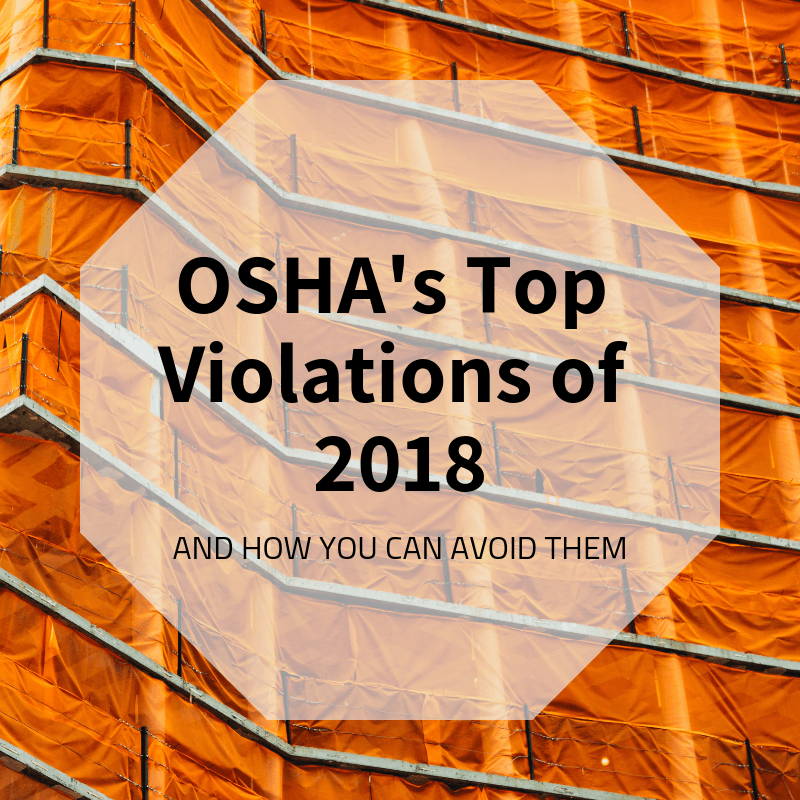It's a new year!
And with that new year comes the round-up of all the old year's news.
Every year, OSHA comes out with the list of the most cited violations of the previous year, and here is where we'll be looking what category the citations fell into in 2018.
*Spoiler alert, this list is almost exactly the same every year for the past 4-5 years.
Now, the only benefit to knowing this sort of thing, is to be able to look at the data and find ways to better protect your business from citations based on what other businesses were cited for.
So without further, ado, here's your top 10 list...
OSHA's Most Cited Violations of 2018
- Fall Protection (More specifically, fall protection in the Construction Industry)
- Hazard Communication
- Scaffolding
- Respiratory Protection
- Lockout/Tagout (Control of Hazardous Energy)
- Ladders
- Powered Industrial Trucks (Forklifts)
- Fall Protection Training Requirements
- Machine Guarding
- Personal Protective Equipment

#1 Fall Protection in Construction
Kicking things off with 7,270 violations in 2018.
Looks like some things never change. How many times have you driven past a roofing contractor who wasn't tied off? Or went past a construction site and thought, "Damn, they aren't afraid of heights are they?"
After working in the Construction Industry and being a site manager in General Industry, I felt like half of my time was devoted to helping problem solve through different fall protection scenarios. If you are in construction, no doubt, you understand the challenge.
To be in compliance in fall protection, you need a written program and you need to uphold that program and either state or federal standards, which can get pretty detailed. However, as #8 suggests, training is going to be the most important component. Otherwise, it's just too easy for employees to take a quick shortcut and risk it.
This one is the most cited for a reason and that's because it's tricky. Your safety culture has to practice what you preach at the training and a lot of care needs to be taken to plan jobs in advance so fall protection plans and resources are available when it comes time to do the work.
#2 Hazard Communication
The Hazard Communication Standard, is the one that says in order to bring a new chemical onsite, you must have the SDS (formerly MSDS) and take the appropriate precautions, educating employees about safe use and providing resources like PPE.
This one is particularly prevalent because it takes so much administrative work to ensure that all chemicals are appropriately managed. The best way to manage this, is have a simple system for storing and accessing your SDS's, continuously educating employees, even if it's just a simple conversation to make sure they understand the requirements and doing periodic audits to verify if your program is working as it should.

#3 Scaffolding
Scaffolding can run smoothly and effortlessly, despite the fact that it's constantly changing and an ever shifting work in progress. The real secret to success, is to have a subject matter expert, an employee who has great understanding of scaffolding requirements, who is given a specific task of auditing the scaffolding at the start of the shift.
In my experience, this the by the far the best practice I've seen in keeping up with scaffolding requirements.
What do you think? What practices have you seen work?
#4 Respiratory Protection
At number 4 with 3,118 violations, is Respiratory Protection. The most common citations included failure to have a written program, failure to conduct fit testing, and failure to provide medical exams.
To access a written program, click here.
Confused about where to get fit testing and medical exams?
Check out this link to OSHA's page on Respirator Fit Testing.
For medical exams, it depends on your location. A medical office that specializes in occupational medicine is a great way to go but if that's not an option, there are mobile services and consultancies around the country that specialize in this area.
#5 Lockout Tagout
With 2,944 violations, this one continues to make the top 10. Lockout is so critically important and sometimes gets left by the wayside, because controlling energy isn't always as straight-forward as it seems. This is especially true in old facilities with electrical modifications, complicated piping systems and in the many cases where there might not be a device that really adequately locks the energy source.
In order to protect your company, you need to ensure that the top violations won't apply to you. These are failure to establish an energy control procedure, failure to provide adequate training, and failure to create equipment-specific procedures. Ask yourself:
- Do I have procedures?
- Is there a specific procedure for each different piece of equipment?
- How good is my training?
This one is just so immensely critical. If you feel this is where your company is lacking, take time to audit how your written program is working in the field and make sure your procedures are specific to equipment and truly do isolate the energy. It's one of the most important things you can do in 2019.
#6 Ladders
- Failure to have side rails extend 3 feet
- Using ladders for unintended purposes
- Using the top step of the ladder
- Ladders with broken steps or rails
#7 Powered Industrial Trucks (AKA Forklifts)
Okay, good news with this one. Although, like ladders, there are a lot of regulations that apply to powered industrial trucks, you can check the main ones off the list fairly easily.The most cited issues were failure to address or remove damaged or defective forklifts from service, operators who had not been trained or certified to operate a forklift, and lastly, failure to evaluate drivers every 3 years.
I know keeping up with this one can be a lot of work, but as you can see, the major issues are pretty straight-forward.
#8 Fall Protection - Failure to Provide Training
At this point, your probably recognize that fall protection is a big one. The training issue alone resulted in 1,982 violations.
Here's the thing, when you start digging in to fall protection issues to find why the safety program isn't working, you often find the records are a mess. And as they say, "if it isn't documented, it didn't happen."
Now, in order for your fall protection training to be legitimately documented, a sign-in sheet often doesn't require all the necessary information. Make sure the training is conducted by a competent person (see OSHA's definition), along with making sure the training covers how employees are to use the equipment, and make sure the training is certified in writing.
When in doubt, include a copy of the training materials in the training record file.
#9 Machine Guarding
With 1,972 violations, we have machine guarding bringing up the rear.
For those of you who have wrestled with these requirements before, you may not be surprised to hear that one of the main issues is guards that are not in place.
You know how it is when you walk up to a piece of machinery, only to find that the guard that is in place to protect employees has been moved by employees because it's "in the way" and never replaced.
Oh, so frustrating, for both you and the employee.
The obvious solution is usually to follow OSHA's requirement that guards must require a tool to be removed. Well, as you might of anticipated, this was another one of the main citations.
#10 Personal Protective Equipment
With 1,536 violations, this one is surprising newbie to the list, taking electrical wiring method's place.
The most common violations were a failure to provide eye and face protection when employees were exposed to flying objects (think grinding), failure to protect against chemicals (another tie-in to the Hazard Communication Standard) and allowing employees to wear both their prescription glasses and safety glasses at the same time. Remember, with that last one you're not supposed to do that because you need the lens to be a safe material.
............................................
We hope that list gives you some ideas of how you can safeguard your business from the most common violations in 2019.
What do you think? Any suggestions on how your business has successfully navigated these challenges?





Leave a comment
All comments are moderated before being published.
This site is protected by hCaptcha and the hCaptcha Privacy Policy and Terms of Service apply.